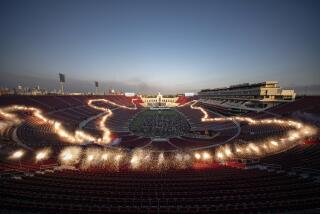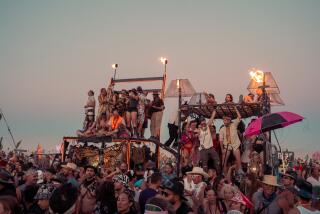Pyrotechnist Lights Up Sky With Aerial Art
Bob Miller splashes reds and blues and golds and silvers against the Long Beach night sky. He views himself as an artist who paints a panorama of bright flashes accompanied by loud booms.
Miller launches the fireworks that appear Friday and Saturday nights over the fantail of the Queen Mary. Officially, he is a pyrotechnist. The license plate on his Honda Civic reads PYRO. But the Ontario man speaks of fireworks as if he were a floral designer--a dash of blue here, a hint of sparkle there.
Consider the âred-tip comets,â one of the 90 types of effects used in the Queen Mary show. âTheyâll start out as a nice beautiful gold . . . and at the end of the tentacles it will burn to a bright red.â
Or a âtiger tail.â He explains: âWhen it comes out of the gun you will see this column of gold that arcs into the sky.â
â1812 Overtureâ
When he thinks of the best fireworks displays, he remembers shows like the one he gave to accompany a performance of Tchaikovskyâs â1812 Overtureâ by the Dallas Symphony Orchestra.
During one passage, he said, he fired a volley of shells that appeared in the sky as a field of gold. Then he started shooting âgreen mareâs tailsâ to give the effect of sprouting plant stems. Next, still in time to the music, came large âchrysanthemumsâ--flower-like bursting shells that filled the sky with changing colors.
âIf you were sitting back, you would see a field with flowers growing in it,â he said.
The Queen Mary show is not quite as elaborate, but it still presents a challenge. Miller, 36, and his team arrive in Long Beach in the late afternoon to set each of 235 onion-shaped skyrocket shells into mortars on the rock dike astern of the old liner. They attach electrical wires to light the fuses.
At 9 p.m., the taped music starts to play. Miller or a fellow crewman from San Diego Fireworks, which has the Queen Mary contract for the summer shows, stands at a control panel about 100 yards from the mortars.
Miller listens as prerecorded cues are called out through a pair of headphones. Each time a number is called, he rubs an electric pencil against a corresponding number on the control panel, which causes an electrical charge that instantly fires the skyrocket.
The trick is to get the skyrockets to explode in time with the music, a feat that requires years of practice because of the delay from the time of launch until the shell detonates. Atmospheric conditions complicate the procedure, affecting the time it takes for the skyrockets to explode.
Moisture Affects Speed
âI watch the shells and can see if they are going off slow or fast in time with the music,â he said. âI will either shoot a half-second early or half-second late in order to keep (up). The black powder in the lifting charge absorbs moisture out of the air. The more moisture, the slower (the fuse) burns.
When the timing is right, the thud of the exploding shells echoes across the Queen Maryâs decks with the beat of such tunes as, âBritannia Rules the Waves.â
âWhen itâs right on, itâs incredible,â said Rick Buche, manager of entertainment at the Queen Mary who regularly attends the shows.
Miller is the first to admit, however, that he tinkers with an imperfect science. Sometimes shells explode prematurely, too late or not at all. As required by his state license, he must shut down the show if winds are blowing too strongly or in a direction that could make the skyrockets a hazard aboard the ship. And pleasure boats sometimes slip into the restricted area directly beneath the bursting fireworks.
If the show is temporarily interrupted, Miller said, he tries to fire the remaining skyrockets whenever appropriate.
âI have creative control and as I know all the shells and (their) location, I will insert them in the show where they best fit the music and theme of the music,â Miller said. âIf they donât fit, I just dump them into the finale.â
Varied Explosives
The finale is an assortment of just about everything that can explode, from a âsalute,â an aerial bomb that erupts into a bright flash with a halo around it, to a âpeony,â another type of flower-like shell that features a smaller, more intense burst than a chrysanthemum.
Miller has become such a fixture in his five summers at the Queen Mary that he is pointed out during his interview by a guide on a passing boat loaded with tourists. They wave at the man in shorts and a beret. Miller waves back.
âI love fireworks,â he said as he wired fuses in the bright afternoon sunshine. âI canât believe they pay me to play with fireworks. Itâs like a Walter Mitty dream.â
The Fourth of July is to pyrotechnists what Christmas is to Santa Claus. Sometimes Miller will travel from state to state to participate in several shows leading up to the national holiday. Besides his Queen Mary duties for San Diego Fireworks, Miller travels with the National Fireworks Ensemble, an elite corps of five pyrotechnists and their crews who arrange super shows of fireworks.
Last year, the ensemble staged one of the shows in Long Beach Harbor under the sponsorship of a local radio station. The skyrockets were launched from two barges to coincide with disco dance music broadcast over the radio.
Miller, a Marine sniper during the Vietnam War, participated in his first fireworks show, a bicentennial Fourth of July show in Arcadia in 1976. He received his license two years later and will have conducted 502 shows in 10 states when the Queen Mary season ends with a Labor Day show.
Through his many shows, Miller has established himself as one of a handful of fireworks technicians who ply their trade in Southern California.
âWeâre lucky to have the guy,â Buche said of Miller. âHe is one of the masters of the business.â
More to Read
Sign up for Essential California
The most important California stories and recommendations in your inbox every morning.
You may occasionally receive promotional content from the Los Angeles Times.










